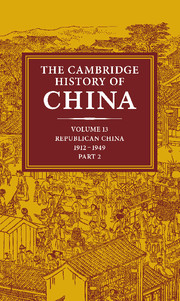Book contents
- Frontmatter
- 1 Introduction: perspectives on modern China's History
- 2 China's international relations 1911–1931
- 3 Nationalist China during the Nanking decade 1927–1937
- 4 The Communist movement 1927–1937
- 5 The agrarian system
- 6 Peasant movements
- 7 The development of local government
- 8 The growth of the academic community 1912–1949
- 9 Literary trends: the road to revolution 1927–1949
- 10 Japanese aggression and China's international position 1931–1949
- 11 Nationalist China during the Sino-Japanese War 1937–1945
- 12 The Chinese Communist movement during the Sino-Japanese War 1937–1945
- 13 The KMT-CCP conflict 1945–1949
- 14 Mao Tse-Tung's thought to 1949
- Bibliographical Essays
- Bibliography
- Conversion table: pinyin to Wade-Giles
- Index
- Republican China - physical features">
- References
8 - The growth of the academic community 1912–1949
Published online by Cambridge University Press: 28 March 2008
- Frontmatter
- 1 Introduction: perspectives on modern China's History
- 2 China's international relations 1911–1931
- 3 Nationalist China during the Nanking decade 1927–1937
- 4 The Communist movement 1927–1937
- 5 The agrarian system
- 6 Peasant movements
- 7 The development of local government
- 8 The growth of the academic community 1912–1949
- 9 Literary trends: the road to revolution 1927–1949
- 10 Japanese aggression and China's international position 1931–1949
- 11 Nationalist China during the Sino-Japanese War 1937–1945
- 12 The Chinese Communist movement during the Sino-Japanese War 1937–1945
- 13 The KMT-CCP conflict 1945–1949
- 14 Mao Tse-Tung's thought to 1949
- Bibliographical Essays
- Bibliography
- Conversion table: pinyin to Wade-Giles
- Index
- Republican China - physical features">
- References
Summary
Institutions of learning not only educate oncoming generations but also create, import and disseminate culture and technology. By performing such vital functions, a modern nation's schools and colleges, libraries and laboratories become of central importance to the state as well as to the society in general. In the Chinese case, moreover, education had from early times been a principal concern of government, and so it would become, eventually, a central focus of the Chinese revolution after 1949. Meanwhile during the first half of the twentieth century, education proliferated in China in the most varied forms and with many kinds of foreign influence and participation. The voluminous record is widely scattered and just beginning to be studied. For example, new work suggests that functional literacy among the common people was more widespread than was formerly assumed. Many important aspects of twentieth-century education need attention – the inheritance of social style and pedagogic method from the thousands of academies (shu-yuan) that had functioned in late imperial China, the growth of a modern school system and of urban public education through the press, the formal education of women, the rise of publishing houses like the Commercial Press (Shang-wu yin-shu-kuan, founded at Shanghai in 1896, a great publisher of journals as well as textbooks), and the founding of educational associations and new schools as seedbeds of reform and revolution. Within this broad terrain, the focus of this chapter is limited to higher education. This fact in itself testifies to the scholarly neglect thus far of the vital story of elementary and secondary education in Republican China.
Keywords
- Type
- Chapter
- Information
- The Cambridge History of China , pp. 361 - 420Publisher: Cambridge University PressPrint publication year: 1986
References
- 1
- Cited by

